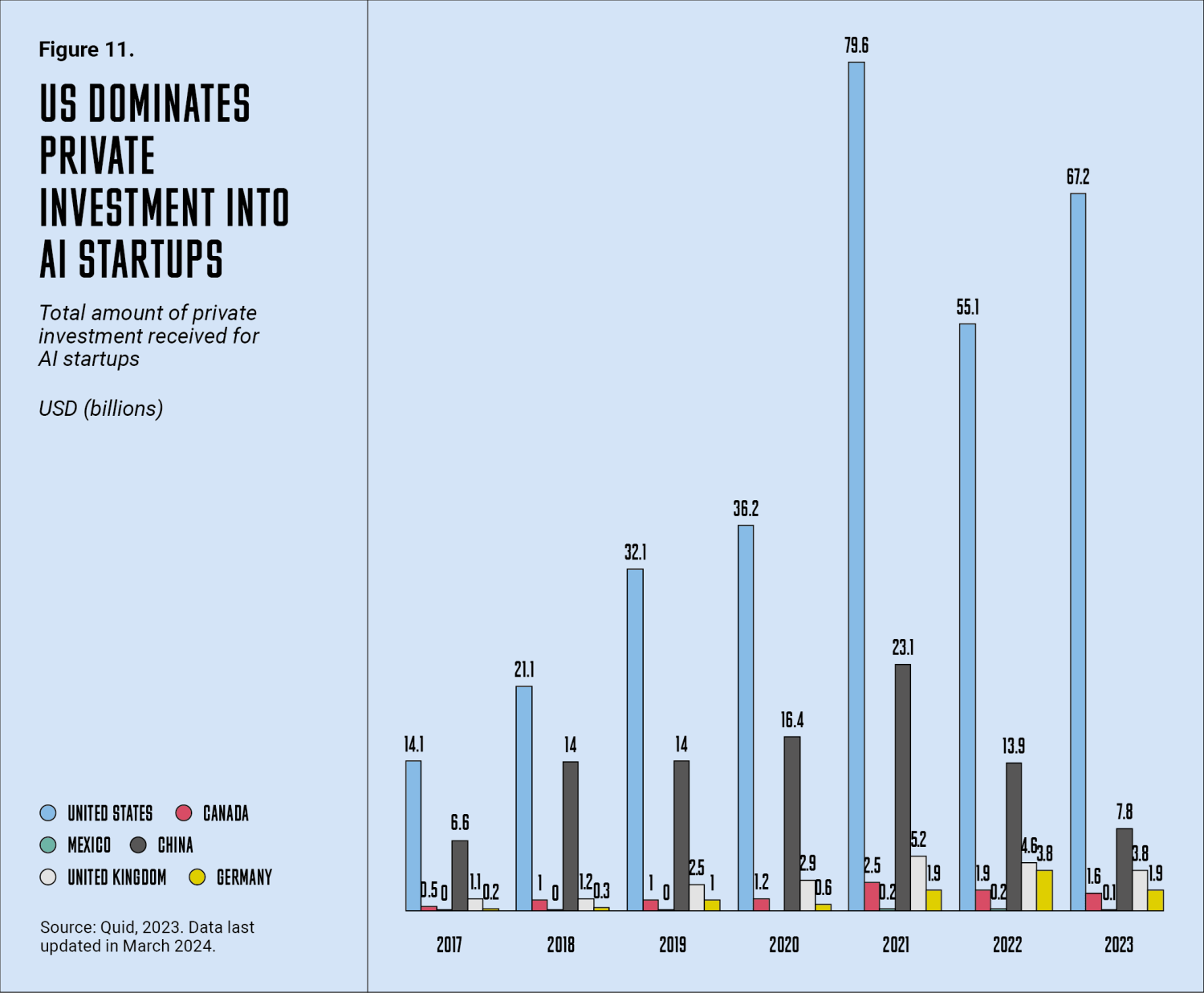This chapter is part of USMCA Forward 2025, which focuses on areas where deepening cooperation between the United States, Mexico, and Canada can help advance key economic and national security goals.
The global artificial intelligence (AI) market is poised for extraordinary growth, projected to reach $3,527.8 billion by 2033, with an annual growth rate of over 30% from 2024 to 2033. North America holds a dominant position in this market, generating approximately $100 billion per year in revenues. And with global competition in AI rising, the importance of the United States-Mexico-Canada Agreement (USMCA) for developing AI is clear.
China has emerged as a fierce competitor in the AI race. In 2017, Beijing unveiled an ambitious plan—the “New Generation Artificial Intelligence Development Plan”—to become the leader in AI development with the goal of becoming the world’s primary AI innovation center by 2030. While the United States still leads globally in AI, China has made remarkable progress and may lead in AI in some areas. For instance, China has surpassed the U.S. in AI and machine learning (ML) patents since 2021. China is also making significant progress developing large language models (LLMs).
The USMCA offers a unique opportunity to strengthen North America’s leadership in AI. The agreement has already laid the groundwork for digital trade by establishing rules that reduce barriers to cross-border data flows and trade in digital goods and services.
U.S. competition with China in AI also included access to the most advanced semiconductors. Taiwan’s TSMC produces over 90% of the world’s advanced computer chips. This concentration exposes the AI supply chain to risk, particularly given tensions between China and Taiwan. In addition, despite restrictions on access to cutting-edge chips, Chinese developers have made significant strides in AI by optimizing less powerful chips and finding loopholes to acquire restricted ones. The new Chinese DeepSeek model exemplifies this strategy; it was developed at a fraction of the cost of comparable models by using fewer advanced technology chips. This progress underscores the stakes for North America as it seeks to remain competitive.
The USMCA offers a unique opportunity to strengthen North America’s leadership in AI. The agreement has already laid the groundwork for digital trade by establishing rules that reduce barriers to cross-border data flows and trade in digital goods and services. However, its provisions have yet to address the challenges and opportunities presented by frontier technologies such as AI.
Context: Overview of the state of AI and technology across North America
The U.S. continues to be a leader in the AI technology race today, topping global rankings in the categories of innovation capacity and technology sector maturity. This feat is driven largely by its position as home to many of the world’s largest technology companies, with private AI investment totaling $67.2 billion in 2023.
While the U.S. lacks a national AI regulation, the country also stands out in governance, thanks to a clear technological vision from the government and AI-specific regulatory initiatives in states such as California and New York. At the federal level, a notable initiative includes former President Joe Biden’s 2022 “Blueprint for an AI Bill of Rights”, designed to guide the development and use of AI to protect people’s privacy and civil rights. However, as part of President Donald Trump’s focus on limiting AI governance—the biggest example of which has been his and JD Vance’s opposition to regulation—arguing that it stifles innovation and undermines the U.S. in the technological race with China, President Trump announced an Executive Order on AI in January of this year.
The United States’ approach to consolidate its AI leadership is closely tied to its national security priorities. For example, the U.S.’ goal of staying ahead of China on AI has led it to implement export controls on high-end AI chips. The Biden administration’s “AI Diffusion Rule” in January 2025 aims to further restrict the flow of advanced AI technologies—including chips and models—to adversarial nations including China. Another key Biden policy is the “Chips and Science Act” launched in 2022, which is designed to bolster domestic semiconductor manufacturing and reduce U.S. reliance on TSMC for high-end chips. Despite criticism from President Trump, who argued that the policy benefits corporations more than U.S. chip manufacturing, Republicans have indicated that the Act is “not on the agenda to be repealed.”
The U.S. continues to be a leader in the AI technology race today, topping global rankings in the categories of innovation capacity and technology sector maturity.
Canada also boasts a world-leading AI ecosystem. In 2017, Canada was the first country to publish a National AI Strategy—the “Pan-Canadian AI Strategy”—and one of the first to propose AI regulation through the “Artificial Intelligence and Data Act (AIDA)” as part of Bill C-27 in 2022, although AIDA looks unlikely to become law. In 2024, former Prime Minister Justin Trudeau announced a $2.4 billion package to boost the Canadian AI sector. This funding is intended to accelerate AI adoption in sectors such as agriculture, healthcare, and manufacturing, with a focus on supporting AI researchers, start-ups, and scale-ups in Canada. Furthermore, in November 2024, the Canadian Artificial Intelligence Safety Institute was launched to ensure the safe development and deployment of AI technologies.
In contrast, Mexico ranks considerably lower when it comes to AI compared to its North American counterparts. This is partly due to the lack of a national AI vision, despite strong scores in terms of data availability, the data’s representativeness of the country’s citizens, and governance and ethics. Although there have been notable efforts to promote AI in Mexico in recent years, government involvement, particularly at the national level, has been limited. In 2018, the “Towards an AI Strategy in Mexico: Harnessing the Benefits of AI” report laid the groundwork for the national “IA-MX 2018 Strategy.” However, the strategy was never implemented following the election of President López Obrador that same year. Since then, Mexico has introduced over 60 AI-related legislative proposals. However, none have been approved. While there has been notable progress in AI governance, most initiatives have been spearheaded by civil society and the industry with limited involvement from the government.
When it comes to the direction of Mexico’s new administration under President Claudia Sheinbaum, several elements indicate a renewed interest in digital technology and AI in particular. These include the establishment of the Digital Transformation and Telecommunications Agency to enhance government technological capabilities, the creation of the Ministry of Science, Humanities, Technology, and Innovation (SECIHTI)1 for the country’s scientific, humanistic, technological, and innovation policy, and the inauguration of the Senate Commission for the Analysis, Follow-up, and Evaluation of the Application and Development of Artificial Intelligence in Mexico to define an AI framework. Mexico’s “National Industrialization and Shared Prosperity Strategy” has also made semiconductors manufacturing a top priority, aiming to double export growth, reduce external dependency by 10%, and foster the development of local suppliers, leveraging its already robust foundation in the semiconductor supply chain.
The building blocks of the USMCA for cross-border collaboration on responsible AI
As trade and security are increasingly intertwined, the upcoming USMCA review should address how the agreement can be used to also strengthen security in the region. For example, the U.S.’ AI Diffusion Rule restricts the sales of high-performance processors and AI licenses to all but 18 allied countries, including Canada—but not Mexico. This exclusion could be related to Mexico’s less robust technology regulatory framework. Given the prioritization of chips and semiconductors, the USMCA offers a valuable opportunity to increase tripartite collaboration, shaping a more resilient and secure regional supply chain that reduces dependency on external markets. As Secretary of State Marco Rubio has pointed out, “Relocating our critical supply chains to the Western Hemisphere would clear a path for our neighbors’ economic growth and safeguard Americans’ own economic security.” This agreement could provide valuable support to the existing efforts, specifically within The Americas Partnership for Economic Prosperity, aimed at enhancing the region’s competitiveness in the semiconductor industry.27
Another key element to increasing North America’s AI competitiveness is maintaining flows of cross border data flow. At the heart of the USMCA’s digital chapter is a strong commitment to allowing data flow across the region, which has been advantageous for industry using data to develop innovative business models and has fostered innovation and enhanced regional competitiveness in AI. However, the USMCA’s Digital Trade chapter has also elicited concerns about privacy protection and the adequacy of existing regulatory frameworks to address the challenges emerging with AI technologies. While the chapter includes provisions to protect personal information and allows for intervention based on “legitimate public policy objectives” critics highlight gaps in addressing issues such as AI-related bias, surveillance, and misinformation. The joint review process could serve as an opportunity to establish regional data privacy frameworks and standards that meet international best practices when it comes to privacy, including transparency, access, right to deletion, and consent.
Another primary area to address in the USMCA review relates to the intellectual property (IP) provisions. The application of IP law to generative AI remains uncertain, including with respect to inventions created by algorithms, ownership of AI-produced works, and the protection of proprietary AI models. USMCA review should explore opportunities to update IP for AI, including standardized and clear definitions for AI-generated works, joint ownership models for cross-border collaborations, and simplified patent applications within the USMCA region to reduce administrative hurdles and encourage innovation. Harmonizing IP standards across North America would not only simplify cross-border innovation but also enhance the region’s competitiveness by fostering a collaborative ecosystem.
AI leadership also depends on a highly skilled workforce. USCMA review could develop strategies to promote specialized skilling programs across North America, such as apprenticeship models, AI-focused vocational training, and cross-border academic partnerships. New policies could also encourage the mobility of AI talent across borders, such as streamlined visas for tech workers within the USMCA. In order to enhance competitiveness, the region could focus talent development in regions with more cost-effective labor. As Mexico embraces its new industrialization strategy centered around semiconductors, strategic investments in talent development within its key digital hubs could represent an opportunity to further unlock the region’s potential.
Finally, while each USMCA member country currently approaches AI governance differently, the agreement presents a unique opportunity to align perspectives and develop common guidelines for developing responsible and trustworthy AI. The inclusion of principles on privacy and cybersecurity concerns in the USMCA establishes a precedent for developing principles for AI. Doing so would position the USMCA as a leading trade agreement on AI that supports innovation as well as responsible development and use of AI.
Conclusion
While the USMCA renegotiations are likely to center around the priorities of the Trump administration, such as drug trafficking and migration, negotiators must keep in mind the strategic importance of AI in maintaining the region’s global competitiveness and competing against China.
Enhancing semiconductor supply chain resilience, strengthening data flow frameworks, adjusting IP provisions, fostering regional talent pipelines, and developing a shared AI governance framework will further bolster North America’s ability to remain competitive while also addressing key security concerns. Quoting Secretary of State Marco Rubio “Making America great again also means helping our neighbors achieve greatness.” By harnessing the collective strength of its three member nations, the USMCA can position the region as an unparalleled leader in AI.
Related viewpoint

-
Footnotes
- Previously, the National Council on Humanities, Science, and Technology (CONAHCYT).
The Brookings Institution is committed to quality, independence, and impact.
We are supported by a diverse array of funders. In line with our values and policies, each Brookings publication represents the sole views of its author(s).





